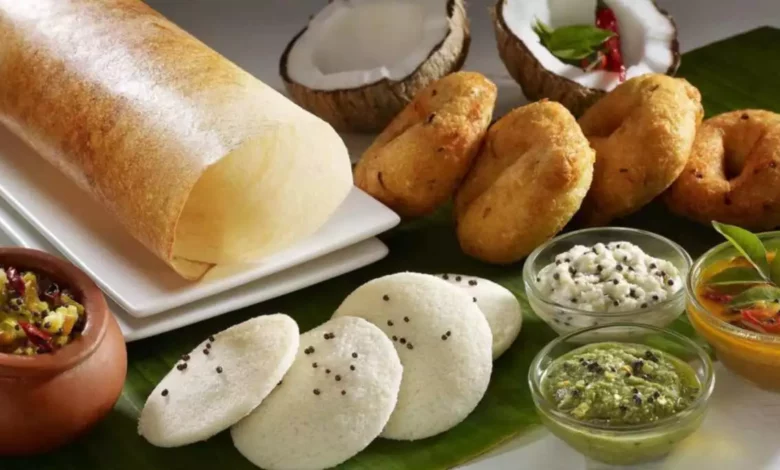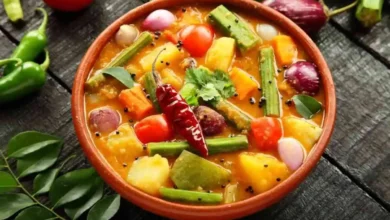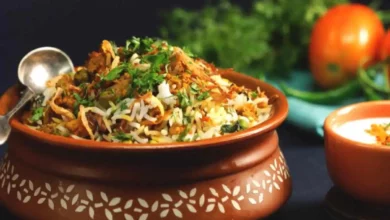South Indian Breakfast – 10 Best Dishes to Treat Yourself

South Indian Breakfast
Table of Contents
Introduction
South Indian cuisine is very extensive and it comprises varied dishes from five South Indian states namely Telangana, Andhra Pradesh, Tamil Nadu, and Karnataka. These states are known for their delicious and unique recipes which are made from locally available ingredients. South Indian breakfast dishes are easy to cook and delicious.
Southern regions of India have very healthy and light breakfast recipes. These dishes are not only tasty but also contain enough protein, fats, and carbohydrates to keep you energized throughout the day. Some recipes require some preparation like soaking rice and lentils for idli and dosa. Dishes like idli, dosa, upma, appam can also be packed in the tiffin box for the kids because they love to eat this kind of food. Most of the dishes have an accompaniment of tangy and sweet chutneys.
South Indian cuisine also contains items that are mainly fermented and hence are rich in probiotics which help in maintaining a healthy gut. Breakfast items like sambhar or rasam are low in calories as they contain a lot of vegetables along with yogurt and pulses. Virgin coconut and sesame oil are the main sources of oil used in cooking which is very good for maintaining heart health.
Let us now look into the 10 most popular & healthy south Indian breakfast dishes that are easy to cook and taste delicious.
South Indian Breakfast: Idli

Idli is a popular breakfast recipe in south India and popular in other parts of India too. Soft and fluffy idlis are served with the sambar and coconut chutney is not only tasty but also very healthy as well. It is one of the healthiest breakfast we can eat in the morning.
South Indian Breakfast: Masala dosa
Let’s dive into the delicious world of masala dosa, a true South Indian culinary masterpiece! Picture this: a crispy golden-brown crepe-like dosa, lovingly filled with a mouthwatering mixture of spiced potatoes, onions, and a medley of aromatic spices. Masala dosa is not just a breakfast favorite; it’s a beloved dish that can be enjoyed any time of the day. The dosa’s crispy exterior perfectly complements the soft and flavorful potato filling, creating a delightful contrast of textures. And let’s not forget the accompanying chutneys and sambar that take this dish to a whole new level.
The tangy coconut chutney and the lentil-based sambar bring a burst of flavors that dance harmoniously on your taste buds. Whether you’re a fan of South Indian cuisine or a curious foodie looking to explore new flavors, masala dosa is a must-try. So, find a cozy spot, grab a masala dosa, and let this scrumptious delight transport you to the vibrant streets of South India with every delicious bite.
South Indian Breakfast: Uttapam

Let’s turn our attention to the delightful Uttapam, a beloved dish from the heart of South India! Uttapam is like a savory pancake that is guaranteed to make your taste buds sing with joy. Picture a soft, fluffy base made from a fermented batter of rice and lentils, studded with a colorful array of vegetables like onions, tomatoes, and green chilies. This vibrant medley of flavors gives Uttapam its unique charm. As it sizzles on the griddle, the aroma wafts through the air, making your mouth water in anticipation. The beauty of Uttapam lies in its versatility – it can be enjoyed as a satisfying breakfast option, a delightful snack, or even a light meal.
Pair it with some tangy coconut chutney or zesty tomato chutney, and you have a winning combination that will leave you craving for more. Whether you’re a die-hard Uttapam fan or a curious foodie looking to explore the wonders of South Indian cuisine, this dish is sure to win your heart. So, grab a plate of Uttapam, share it with friends and family, and let the delicious flavors transport you to the sunny shores of South India. Prepare yourself for a delightful culinary adventure that will leave you wanting seconds and thirds!
South Indian Breakfast: Medu vada
Let’s take a moment to appreciate the mouthwatering delight known as Medu Vada, a beloved South Indian snack that will leave you craving for more! Imagine a perfectly shaped, golden-brown crispy exterior, giving way to a soft and fluffy center. Medu Vada is like a savory donut, but with a burst of flavor that is sure to tantalize your taste buds. Made from a batter of soaked and ground lentils, seasoned with a delightful blend of spices and herbs, these vadas are a true culinary delight. As they fry to perfection, the aroma fills the air, making it impossible to resist their delicious allure.
Whether you enjoy them as a breakfast treat, a tea-time snack, or a party appetizer, Medu Vadas are always a hit. Dip them in some tangy coconut chutney or spicy sambar, and you have a match made in food heaven. So, whether you’re a fan of South Indian cuisine or simply looking for a scrumptious snack to satisfy your cravings, make sure to try Medu Vada. These crispy, flavorful delights will leave you wanting more with each irresistible bite. Get ready to savor the magic of Medu Vada and let it transport you to the vibrant streets of South India where these delectable snacks are a beloved part of the culinary tradition.
South Indian Breakfast: Khara Pongal

Let’s dive into the world of Khara Pongal, a warm and comforting dish that is sure to win over your taste buds! Khara Pongal is a traditional South Indian delicacy that combines the goodness of rice and lentils in a heavenly marriage of flavors. Imagine a steaming bowl of creamy goodness, with each spoonful offering a delightful blend of textures and aromas. The perfectly cooked rice and lentils create a soft and velvety base, while the fragrant spices like cumin, pepper, and ginger add a burst of savory goodness.
The dish is often garnished with ghee and topped with crunchy cashews and aromatic curry leaves, elevating it to a whole new level. Khara Pongal is not just a treat for your taste buds; it is also a comfort food that soothes the soul. Whether you enjoy it for breakfast, lunch, or dinner, Khara Pongal is always a satisfying and nourishing choice. So, grab a spoon, indulge in this hearty dish, and let the flavors transport you to the rich culinary traditions of South India. With each spoonful, Khara Pongal brings warmth, comfort, and a delicious taste of South Indian hospitality.
South Indian Breakfast: Upma
Let’s talk about the delightful and versatile dish called Upma! Whether you’re a fan of savory breakfasts or looking for a quick and satisfying meal, Upma has got you covered. This South Indian specialty is made from semolina or coarse rice flour, cooked to perfection with a flavorful blend of spices, vegetables, and sometimes even nuts. Upma is like a comforting hug for your taste buds, offering a wonderful combination of textures and flavors.
The fluffy grains of semolina or rice flour are perfectly complemented by the crunchy bits of vegetables, creating a delightful balance. The aromatic spices like mustard seeds, curry leaves, and turmeric add a burst of savory goodness that will awaken your senses. Upma is not just a delicious dish; it’s also incredibly versatile.
You can customize it with your favorite vegetables, add a dash of tanginess with lemon juice, or even enjoy it with a side of chutney or pickle. Whether you’re enjoying it for breakfast, brunch, or as a light dinner, Upma is a satisfying and wholesome choice. So, next time you’re looking for a quick and flavorful meal, give Upma a try. It will transport you to the vibrant streets of South India, where this beloved dish is enjoyed by people of all ages. Get ready to savor the goodness of Upma and let it become a comforting part of your culinary repertoire.
South Indian Breakfast: Puttu

Puttu is a popular dish that is primarily a steamed log which is made with rice flour and coconut. Served hot with curry of black chickpeas known as kadala, it has a wonderful aroma. It can also be served with potato curry or any other vegetable of your choice.
South Indian Breakfast: Idiyappam
Let’s explore the culinary delight known as Idiyappam, a beloved dish from the southern regions of India! Idiyappam is like a delicate work of art, made from rice flour and water, steamed to perfection. It takes the form of thin, string-like noodles that are soft and fluffy, with a subtle nutty flavor. These delightful strands of goodness are often enjoyed with a variety of accompaniments, such as coconut milk, spicy curries, or tangy chutneys. Idiyappam is not just a treat for your taste buds; it’s also a visual delight that brings a touch of elegance to your plate.
The process of making Idiyappam involves skill and precision, turning simple ingredients into a culinary masterpiece. Whether you enjoy it for breakfast, lunch, or dinner, Idiyappam is always a light and satisfying choice. So, next time you’re in the mood for something unique and delicious, give Idiyappam a try. Let its delicate texture and delightful flavor transport you to the beautiful landscapes of South India, where this culinary gem is cherished by locals and visitors alike. Get ready to savor the magic of Idiyappam and let it become a cherished part of your culinary journey.
South Indian Breakfast: Pessarattu
These crepes are made from green moong which is a type of lentil in India and is a healthy and nutritious dosa variety. Vegan as well as gluten-free, this light breakfast recipe is very popular in Andhra Pradesh.
South Indian Breakfast: Mysore Bonda

Let’s talk about the delightful and irresistible Mysore Bonda! These golden-brown, round fritters from the vibrant city of Mysore in South India are a true culinary delight. Imagine biting into a crispy exterior that gives way to a soft and fluffy center. Mysore Bonda is like a flavor explosion in your mouth, with each bite delivering a burst of savory goodness. Made from a fermented batter of urad dal and spiced with ginger, green chilies, and curry leaves, these fritters are a perfect blend of textures and flavors. They are best enjoyed hot, straight from the frying pan, accompanied by a cup of hot tea or a tangy coconut chutney.
Mysore Bonda is not just a snack; it’s a comforting treat that brings people together. Whether you’re enjoying it as a quick bite on a rainy day or serving it as an appetizer at a gathering, Mysore Bonda is sure to be a crowd-pleaser. So, indulge in the crispy, fluffy goodness of Mysore Bonda and let it transport you to the lively streets of Mysore, where this beloved snack is a culinary star. Get ready to savor the magic of Mysore Bonda and create delightful memories with friends and family.
Conclusion
In conclusion, South Indian breakfast is a culinary adventure that shouldn’t be missed. With its vibrant flavors, diverse range of dishes, and wholesome ingredients, it offers a delightful start to the day. From the iconic masala dosa and fluffy idlis to the comforting pongal and crispy vadas, South Indian breakfast is a treat for both the palate and the soul. Whether you’re a fan of spicy and tangy flavors or prefer something mild and comforting, the top 10 dishes featured in this article have something for everyone. So, treat yourself to the flavors of South India and embark on a gastronomic journey that will leave you craving for more.
Indulge in the rich coconut chutneys, tangy sambar, and aromatic spices that make South Indian breakfast truly exceptional. Don’t miss out on this culinary delight that has captured the hearts of food lovers worldwide. Experience the magic of South Indian breakfast and let it awaken your senses with its authentic flavors and unforgettable taste. Start your day right with these appetizing dishes and let the flavors transport you to the enchanting land of South India, where breakfast is a celebration of food and culture.




